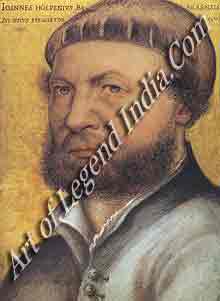 German
Great Artist - Hans Holbein Life
German
Great Artist - Hans Holbein Life
The son
of a successful German artist, Hans Holbein worked in Switzerland before the
religious turmoil of the Reformation caused him to leave for England in search
of work. His first stay in London was spent among the circle of the great
scholar and statesman Sir Thomas More. After a period back in Switzerland with
his wife and family, Holbein returned to England, where he remained based until
his death from the plague.
Holbein's
phenomenal skill particularly at portrait painting was exploited by Henry VIII's
secretary, Thomas Cromwell, who drew him into the king's employ. Soon, Holbein
became Henry VIII's chief image-maker. Though little is known about his
character, Holbein seems to have been a cultivated but cold man, who could
switch his allegiance from More to Cromwell the man who ordered More's untimely
death.
A German at the English Court
Hans
Holbein moved to London permanently from his native Germany in 1532. His work
soon found favour at court and he was appointed King's Painter. Holbein died in
1543 of the plague.
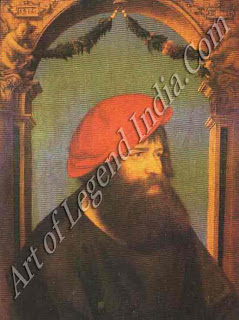 Very
little is known about the life of Hans Holbein the Younger. Only a few dated
documents and Holbein's works themselves - including some enigmatic selfportraits
provide us with clues to the personality of the man who became King Henry Vu's
favourite painter.
Very
little is known about the life of Hans Holbein the Younger. Only a few dated
documents and Holbein's works themselves - including some enigmatic selfportraits
provide us with clues to the personality of the man who became King Henry Vu's
favourite painter.
Holbein
was born in 1497/8 in Augsburg in Southern Germany. His father, Hans Holbein
the Elder, was a gifted painter and had already carved quite a reputation for
himself. Together with his elder brother, Ambrosius, the young Holbein trained
for a while in his father's studio, and in 1514 the two boys were sent to Basel
in Switzerland to serve their apprenticeships with the painter Hans Herbster.
In
Basel, Holbein also worked for the publisher, Froben, producing book illustrations
and a set of marginal drawings for Desiderius Erasmus's book Praise of Folly.
This very important commission put him in touch with Basel's humanist circle,
of which the scholar Erasmus was the leading light.
THE HUMANISTS
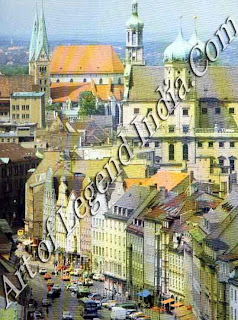 The
humanists placed paramount importance on the intellectual pursuits, potential
and wellbeing of mankind. Whereas medieval Christianity had taught the
insignificance of man's earthly existence, the humanists believed in the value
of human endeavours. They found the basis for their ideas in the literature and
philosophy of the ancient Greeks and Romans, where the virtues of liberality,
eloquence and wisdom were especially prized. Holbein seems to have gradually
formed close friendships with some of the northern humanists, particularly
Erasmus. Early on in his career his own humanistic interests were reflected in
the sophisticated classical details he introduced into his designs and
decorative schemes.
The
humanists placed paramount importance on the intellectual pursuits, potential
and wellbeing of mankind. Whereas medieval Christianity had taught the
insignificance of man's earthly existence, the humanists believed in the value
of human endeavours. They found the basis for their ideas in the literature and
philosophy of the ancient Greeks and Romans, where the virtues of liberality,
eloquence and wisdom were especially prized. Holbein seems to have gradually
formed close friendships with some of the northern humanists, particularly
Erasmus. Early on in his career his own humanistic interests were reflected in
the sophisticated classical details he introduced into his designs and
decorative schemes.
In
1517, and again in 1519, Holbein travelled to Lucerne, Switzerland, where he
decorated the house of the town's chief magistrate in a splendid illusionistic
style. At some point, probably in 1518, Holbein made a short trip to Italy
where the work of the Renaissance painters Andrea Mantegna and Leonardo da
Vinci made a profound impression on him. Once back in Basel, he soon showed Himself
to be a painter of great talent. He was extremely prolific, too, turning out
portraits, altarpieces and designs for stained glass, as well as a series of
huge frescoes.
Key Dates
C.1487 born in Augsburg,
southern Germany
1519 marries Elsbeth Binsenstock
1526 first visit to England;
introduction to Sir Thomas More
1528 returns to Basel
1533 paints The Ambassadors
1534 Henry VIII becomes Supreme
Head of the Church; Thomas More imprisoned; Holbein paints Thomas Cromwell
1537 appointed King's Painter
1543 dies of the plague in London
In 1519
Holbein joined the painters' guild and rapidly achieved the status of chamber
master. At this time he married Elsbeth Binsenstock, the widow of a tanner, who
already had one son. In time they had two sons of their own, who became
goldsmiths, and two daughters. It is assumed that He also had a mistress, a
certain Magdalena Offenburg, whom he painted in the appropriate guise of Lais the
mistress of the legendary Greek painter, Apelles. Magdalena probably also
modeled somewhat less appropriately for the Virgin in The Meyer Madonna.
In an
astonishingly short time Holbein had become the foremost artist of the northern
humanist movement. Among his finest works of this period are the three
portraits he painted of Erasmus and a series of anti-clerical woodcuts
illustrating the Dance of Death. In 1524 he visited France and expanded his
artistic horizons. But two years later the violent impact of the Reformation
brought religious painting in Basel to an abrupt halt and he was forced to seek
prestigious commissions elsewhere.
INTRODUCTION TO THOMAS MORE
Armed
with a letter of introduction from Erasmus to none other than Sir Thomas More
and Arch-bishop Warham, Holbein left for England 'to pick up some angels'
(coins), as Erasmus put it. He was welcomed by more in London and it is
believed that he stayed at his Chelsea house for the remainder of his visit.
Henry VIII had not yet begun his great program me of art patronage and so
Holbein did not work for the Crown at this time, but he probably met the king,
who was then in the habit of rowing down the Thames in his barge and calling on
his close friend More without warning. More was then approaching the height of
his political influence: the king relied on him both for company and advice,
and he was soon to be made Lord Chancellor.
Thus,
at a single bound, Holbein vaulted into the centre of political and
intellectual life in England. He exploited his opportunity to the hilt. His
sitters, all drawn from More's circle, included the king's astronomer and the
Archbishop, who had him painted in the same pose as Erasmus. The finest
portrait of this period, and perhaps of all Holbein's English output, was that
of more himself, conveying the man's aura of power as well as the sensitivity
of his intellect. Still more impressive perhaps would have been his group
portrait of the More family, but it has since been destroyed by fire.
In
1528, Holbein returned to Basel; he had only been granted a two-year leave of
absence and a longer stay would have cost him his citizenship. Also, the
Council had work for him. He bought two adjoining houses overlooking the Rhine
and settled down to paint frescoes for the Town Hall. During this period he
painted a sympathetic and intimate portrait of his wife and two of their children.
A RETURN TO LONDON
Meanwhile,
the situation in Basel was rapidly worsening. The Lutheran faction was at its
most extreme: Erasmus was forced to flee and iconoclasts destroyed nearly all
the city's religious paintings in a single day. Holbein obtained some minor
commissions decorating a tower clock in the city and designing patterns for
goldsmiths, jewelers and glassmakers; he even made some costume designs. But
the atmosphere was highly unfavorable to art of all sorts, and Holbein although
he supported the principles of the Reformation decided to return to London.
He
arrived late in 1532 to discover that events were moving very fast there too.
Archbishop Warham had died and Thomas More, having refused to endorse the
king's marriage to Anne Boleyn, had petitioned to resign the chancellorship. He
was now trying to live in Unobtrusive privacy and Holbein was obliged to turn
to another source of patronage. This he found among the German merchants at the
Steelyard, which was the London trading office of the Hanseatic League. At this
time he painted a magnificent full-length double portrait The Ambassadors, and
the virtuoso George Gisze, both designed to attract the attention of Tudor
court.
The
status of his patrons rose quickly. By 1534 he was painting the king's
secretary, Thomas Cromwell. In this same year more refused to swear the Oath of
Supremacy, declaring that 'no parliament could make a law that God should not
be God'. The king, who was now Supreme Head of the Church of England, had him
cruelly Imprisoned in the Tower, where he languished for another year while the
Crown's agents, directed by Cromwell, prepared their case against him.
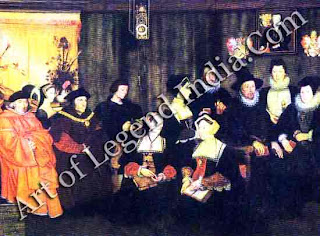 Though
Cromwell was repulsive in appearance and character, qualities which are not
shirked in Holbein's portrait, he was the most important patron Holbein could
have acquired. During the next five years he not only filled the royal coffers
with monastic gold, but orchestrated the most lavish propaganda campaign in the
arts ever undertaken for the benefit of the Crown. One of the first jobs he
gave Holbein was to design a woodcut for the title page of the Coverdale Bible,
the first complete edition of the Bible in English. This showed Henry VIII
delivering the Word to the bishops.
Though
Cromwell was repulsive in appearance and character, qualities which are not
shirked in Holbein's portrait, he was the most important patron Holbein could
have acquired. During the next five years he not only filled the royal coffers
with monastic gold, but orchestrated the most lavish propaganda campaign in the
arts ever undertaken for the benefit of the Crown. One of the first jobs he
gave Holbein was to design a woodcut for the title page of the Coverdale Bible,
the first complete edition of the Bible in English. This showed Henry VIII
delivering the Word to the bishops.
In July
1535 Thomas More was executed and in the following year Anne Boleyn was the
first of Henry VIII's wives to lose her head. Holbein was now on the royal
payroll, and in 1537 he was appointed the King's Painter. For an annual income
of about £30, he performed a great variety of commissions for his royal master from
the design of his state robes to that of his book bindings. But he was chiefly
valued for being 'very excellent in making Physiognomies'. By this time, the
King had banned all religious painting.
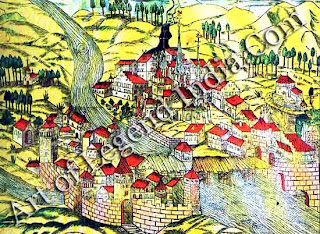 Though
he was a genius as a painter, as a man Holbein seems to have been shrewd,
ambitious, ruthless and quite unscrupulous. Admittedly, the turbulent and
bloody politics of those days made compromise and sudden switches of loyalty a
virtual necessity for anyone close to the throne, even artists. But for all
that, it is difficult not to be surprised by someone who was able to sell his
talent to Cromwell, the man responsible for the death of more, his onetime
friend, patron, host and sponsor.
Though
he was a genius as a painter, as a man Holbein seems to have been shrewd,
ambitious, ruthless and quite unscrupulous. Admittedly, the turbulent and
bloody politics of those days made compromise and sudden switches of loyalty a
virtual necessity for anyone close to the throne, even artists. But for all
that, it is difficult not to be surprised by someone who was able to sell his
talent to Cromwell, the man responsible for the death of more, his onetime
friend, patron, host and sponsor.
A rare
insight into Holbein's character (or his reputed character) comes from an
anecdote told by The Flemish artist and art historian Karel van Mander. The
story goes that Holbein was painting a portrait of a lady for King Henry, when
a nobleman appeared in the room unannounced. The artist was so angered by the
interruption that he flung the offending intruder downstairs then hurried to
offer his apologies to the king.
PAINTING THE KING
In the
year 1537, Holbein was given his most momentous task when he was asked to paint
a commemorative group portrait of Henry VIII, his new Queen, Jane Seymour, and
the king's parents Henry VII and Elizabeth of York, which was to adorn the wall
of the Privy Chamber above the throne itself. In the event, Jane Seymour died
before the fresco was completed, having given birth to Henry's only and long
awaited son. 1537 was in every respect a year of shattering triumph for the
Tudor dynasty. Henry managed decisively to crush the most serious rebellion of
his reign, the so-called Pilgrimage of Grace, and showed the Pope to be
powerless to challenge his position as Supreme Head, next to Christ, of the
Church of England. The great fresco was therefore conceived as a celebration of
victory, peace and dynastic unity. Holbein had the job of enshrining in paint
the official Tudor view of the immediate past.
We can
only guess at the visual effect of his fresco, though every contemporary
reference testifies to its awesome power. For in 1698 the negligence of a
chamber maid caused the palace of Whitehall to be burnt to the ground.
Having
completed the Whitehall wall painting, Holbein was sent abroad with the
delicate task of painting likenesses of Henry's possible future wives. He
visited Brussels where he painted a portrait of the delightful Christina of
Denmark, which 'singularly pleased the king' and put him in a fine humour.
However, political negotiations broke down, and Henry never married her. For a
similar reason Holbein also painted a bland but pretty portrait of Anne of
Cleves, whom the King decided to marry (though he later described her as 'the
Flanders Mare').
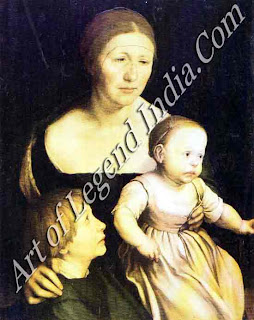 In
September 1538 Holbein returned once more to Basel and his family. A banquet
was held in his honour and the city offered him a pension and other privileges
in the hope of tempting him to stay permanently. But he did not linger. Though
he was never naturalized, London had become his home as well as the centre of
his career.
In
September 1538 Holbein returned once more to Basel and his family. A banquet
was held in his honour and the city offered him a pension and other privileges
in the hope of tempting him to stay permanently. But he did not linger. Though
he was never naturalized, London had become his home as well as the centre of
his career.
In his
last years, Holbein painted less for the king, but there is no evidence that he
fell out of favour. Indeed, his last, unfinished work was a large painting of
Henry VIII granting the charter to the Barber-Surgeons' company. He also
continued to work for the Crown by travelling abroad on diplomatic missions
about which little are known.
DEATH FROM THE PLAGUE
Holbein's
life was cut short by the plague which raged through London in 1543. The will
he made in that year reveals that he was a resident in the parish of St Andrew
Undershaft in the City of London, and that he left two illegitimate 'chylder which
be at nurse'. But despite Holbein's illustrious career, his will contains no
mention of any property: only small items such as clothing and a horse. In fact
he left several debts. But the debt which English art owes to the foreigner
from Germany is far greater: he influenced the direction of English art for
centuries to come.
Writer- A Marshall Cavendish
 Very
little is known about the life of Hans Holbein the Younger. Only a few dated
documents and Holbein's works themselves - including some enigmatic selfportraits
provide us with clues to the personality of the man who became King Henry Vu's
favourite painter.
Very
little is known about the life of Hans Holbein the Younger. Only a few dated
documents and Holbein's works themselves - including some enigmatic selfportraits
provide us with clues to the personality of the man who became King Henry Vu's
favourite painter.  The
humanists placed paramount importance on the intellectual pursuits, potential
and wellbeing of mankind. Whereas medieval Christianity had taught the
insignificance of man's earthly existence, the humanists believed in the value
of human endeavours. They found the basis for their ideas in the literature and
philosophy of the ancient Greeks and Romans, where the virtues of liberality,
eloquence and wisdom were especially prized. Holbein seems to have gradually
formed close friendships with some of the northern humanists, particularly
Erasmus. Early on in his career his own humanistic interests were reflected in
the sophisticated classical details he introduced into his designs and
decorative schemes.
The
humanists placed paramount importance on the intellectual pursuits, potential
and wellbeing of mankind. Whereas medieval Christianity had taught the
insignificance of man's earthly existence, the humanists believed in the value
of human endeavours. They found the basis for their ideas in the literature and
philosophy of the ancient Greeks and Romans, where the virtues of liberality,
eloquence and wisdom were especially prized. Holbein seems to have gradually
formed close friendships with some of the northern humanists, particularly
Erasmus. Early on in his career his own humanistic interests were reflected in
the sophisticated classical details he introduced into his designs and
decorative schemes.  Though
Cromwell was repulsive in appearance and character, qualities which are not
shirked in Holbein's portrait, he was the most important patron Holbein could
have acquired. During the next five years he not only filled the royal coffers
with monastic gold, but orchestrated the most lavish propaganda campaign in the
arts ever undertaken for the benefit of the Crown. One of the first jobs he
gave Holbein was to design a woodcut for the title page of the Coverdale Bible,
the first complete edition of the Bible in English. This showed Henry VIII
delivering the Word to the bishops.
Though
Cromwell was repulsive in appearance and character, qualities which are not
shirked in Holbein's portrait, he was the most important patron Holbein could
have acquired. During the next five years he not only filled the royal coffers
with monastic gold, but orchestrated the most lavish propaganda campaign in the
arts ever undertaken for the benefit of the Crown. One of the first jobs he
gave Holbein was to design a woodcut for the title page of the Coverdale Bible,
the first complete edition of the Bible in English. This showed Henry VIII
delivering the Word to the bishops.  Though
he was a genius as a painter, as a man Holbein seems to have been shrewd,
ambitious, ruthless and quite unscrupulous. Admittedly, the turbulent and
bloody politics of those days made compromise and sudden switches of loyalty a
virtual necessity for anyone close to the throne, even artists. But for all
that, it is difficult not to be surprised by someone who was able to sell his
talent to Cromwell, the man responsible for the death of more, his onetime
friend, patron, host and sponsor.
Though
he was a genius as a painter, as a man Holbein seems to have been shrewd,
ambitious, ruthless and quite unscrupulous. Admittedly, the turbulent and
bloody politics of those days made compromise and sudden switches of loyalty a
virtual necessity for anyone close to the throne, even artists. But for all
that, it is difficult not to be surprised by someone who was able to sell his
talent to Cromwell, the man responsible for the death of more, his onetime
friend, patron, host and sponsor. In
September 1538 Holbein returned once more to Basel and his family. A banquet
was held in his honour and the city offered him a pension and other privileges
in the hope of tempting him to stay permanently. But he did not linger. Though
he was never naturalized, London had become his home as well as the centre of
his career.
In
September 1538 Holbein returned once more to Basel and his family. A banquet
was held in his honour and the city offered him a pension and other privileges
in the hope of tempting him to stay permanently. But he did not linger. Though
he was never naturalized, London had become his home as well as the centre of
his career. 

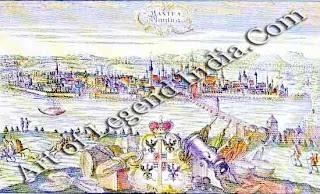
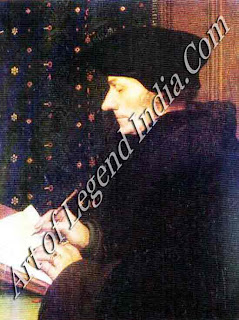











0 Response to "German Great Artist - Hans Holbein Life"
Post a Comment